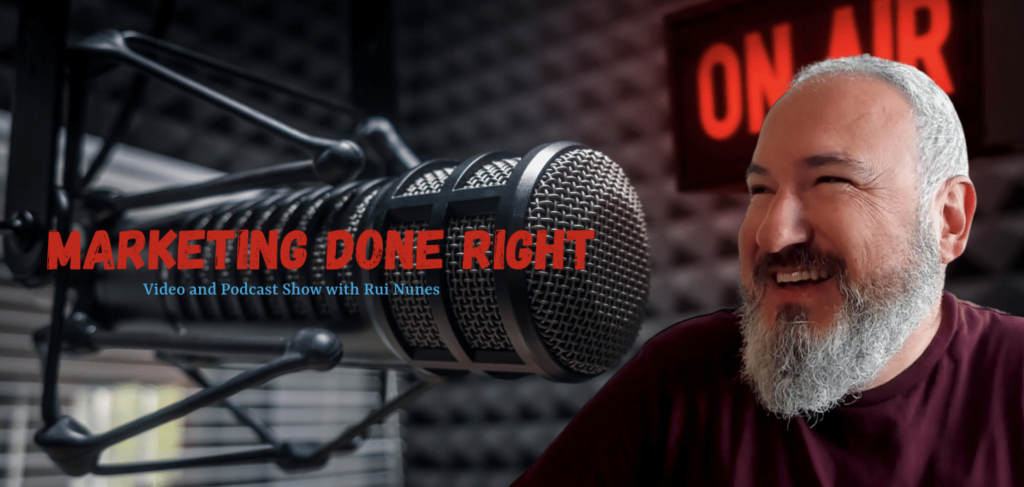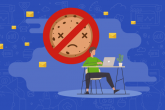Rui Nunes is a visionary entrepreneur based in Portugal. He is the founder of sendXmail(s) – email marketing and automation full-service agency and ZOPPLY – full digital service agency, two companies build to help businesses thrive in the digital age.
Having a creative background and being involved in various educational settings as a teacher, trainer, and consultant for companies and marketing schools, he strongly believes that a CEO or founder is the best marketing asset a company can have.
His extensive experience in email marketing makes him a thrill to talk to and we’re honored to have him on our blog today.
In this exclusive conversation, Rui shared with us:
- what it’s like to run two companies,
- the competitive advantage of his companies,
- how has the pandemic determined businesses to reconsider email,
- how is technology upgrading email automation,
- his predictions about the trends and future challenges in email marketing,
- what are the core tactics publishers should focus on in their email strategies,
- why did he launch his own YouTube channel,
- his favorite books, podcasts and newsletters,
- precious advice for new entrepreneurs in email,
- and many other inspirational thoughts.
So let’s begin!
Rui, we’re so thrilled to have you with us! Can you tell us a little more about your background and the companies you founded?
Sure. It’s a pleasure to be a part of your interviews.
My background is as a creative for advertising agencies but soon begun my career in digital marketing.
I was challenged to be part of the team that gathered the world’s largest permission-based email marketing list in Portuguese and Spanish language from 2000 to 2012.
After that, my entrepreneurial side showed up, and I started three or four companies since then. In between, a French multinational company challenged me to assume their digital marketing department as their head of digital and made some consultant gigs in between.
For now, I’m focused on sendXmail(s) and ZOPPLY. I don’t even consider it a job. I have fun doing what I do every day.
What sets sendXmail(s) and ZOPPLY apart from other companies in the market? Can you share more about what was the trigger for creating them?
The reason to start these two companies apart is that each goal and target is different. I thought about starting just one company or brand, but it would be too much noise to pass the right message into the market.
sendXmail(s) is an Email Marketing and Automation full-service agency. We provide all the assistance to brands who want to leverage their email marketing or marketing automation channels. As an outsourced team for these channels, we can do it all or audit and provide strategies for their marketing teams to implement.
ZOPPLY is a full digital service agency for small and medium enterprises. You might think of us as a brand’s outsourced digital department. We take care of all the brand’s online presence and campaigns with specific goals to achieve each month.
Usually, with the typical digital agency model, you pay upfront for a website, landing pages, materials, etc.
With ZOPPLY, you have a monthly fee covering a continuously updated online presence to show results.
What sets both of these companies apart from the competition is the transparency of what we do and the level of expertise in these key areas. Our goal is not to do everything. In fact, we work with a lot of other agencies and marketing teams. We stick to where we have a competitive advantage, and that’s it.
Answering your question about what triggered me to start these companies was due to my passion for helping companies thrive. Previously I was in a company where other brands invested millions of euros into campaigns for a short-term goal. The goal for investing into their own lists and audience was not there, and it was a complete waste of budgets in my mind. That was the genesis for sendXmail(s).
The spark that made me create ZOPPLY was because the current digital agency business model was not adequate anymore. Brands investing in an online presence that was inert for a few years, and every time they change agencies, the first thing they ask is to change everything again. It’s crazy.
Since last year, more and more brands started to (re)consider email as the best channel to communicate with their audiences. Do you think this shift would have happened anyway, or was it an effect of the pandemic?
It would have happened anyway, in my opinion, but the pandemic helped to that visible growth.
If you think about it, several new startups based on email were created or started to be developed a few months before the pandemic began. We’re talking about Superhuman, HEY, and so many others. That’s a symptom that the email market showed a sign of going back to email, after so many vaticinated email’s death, like Slack and other tools.
But above all of these signs, there’s one main reason for brands (re)considering email as a major channel. It still gives tremendous ROI compared to the other media available. It’s simple math.
If we let go of the buzzwords or new shiny things, email marketing keeps on delivering. According to the DMA UK, for every 1€ invested, you get above 41€ in return. That’s huge if you ask me. Not many strategies can get you this kind of ROI.
But the pandemic has helped to accelerate this reconsideration of email marketing. Especially because brands worldwide needed to stay in touch with their audience, and the best way to get that 1-to-1 approach in digital still is through email.
What creators and authors soon realized is that people were more willing to pay to get a newsletter. That’s also the reason why Substack, Convertkit and Patreon, to name a few services, seen a surge in their services. Some big brands are entirely based on their lists, like MorningBrew, for instance.
These signals provided the necessary attraction for companies to look at email marketing again with a different look.
How do you think technology is upgrading the email marketing automation sector?
What has become clear is that technology has rapidly evolved to a point where budget is no longer the issue. The competition and technology have grown so that even a small or medium enterprise can now access the “big boys” tools.
A costly marketing automation solution is now open for anyone with a small budget to start testing in a few months. Email is a perfect channel for that.
Of course, some of the marketing automation that we implement is very complex and need several platforms integrations. But very few companies need such complexity. Even if we start with simple email marketing automation, we can achieve incredible results.
That explains some of the incredible success of platforms like ActiveCampaign, Privy and Klavyio, to name a few. It’s already filled with some email automation recipes that you can activate even without much expertise in the area.
Technology has evolved to a point where you can even insert programmatic ads into our newsletters seamlessly, like the inboxAds platform that you run. Who would have thought of that a few years back?
What are some of your predictions regarding the trends, as well as future challenges in email marketing?
We just mentioned how technology has made it possible for everyone to start using email marketing automation, and then we faced another challenge. GDPR and other privacy concerns have brought us to a trend where data privacy is a major push for many developments.
We’re talking about Apple’s recent advocacy for privacy under their iOS, Google’s talking about a cookieless solution and many other things. All of this will prevent some of this automation from working as they were once thought of.
I guess that’s more than a trend; it’s a reality. We need to respect our subscribers’ wishes and privacy more.
We used to sell them the idea that we need to track their behavior to deliver more personalized emails, but that was a lie most of the time. Our laziness in providing that better experience has become clear, and now they don’t want to believe it anymore.
We need to ask our subscribers’ permission to track their behavior and deliver on the promise. Our KPI’s might have changed a bit, but email is still a massive channel regardless of what we track or not.
Content personalization and AI will become the primary differentiator between good and outstanding results. Humans behind a monitor will no longer be able to deliver that personalized experience to every single subscriber if they’re not assisted by artificial intelligence.
Studies show that AI is getting better results across the board. It’s also the most rational choice to scale without hiring a team of hundreds of people to do what this technology can.
Another trend that has become a reality is paid newsletters. Several professionals across every industry are profiting from having a niche paid newsletter. We even have one for our sendXmail(s) where people pay to access a weekly digest of insights, tips and ideas. It’s not our goal to have a different revenue stream but to be a qualifier for our traffic.
So far, each of our paid newsletter subscribers has requested a business quote for our services after three weeks (on average) of subscribing. So, that’s our primary goal.
You address your services to small and medium-sized businesses. What should your customers consider when investing in email, and what would be the core tactics they should focus on in their email strategies?
In fact, ZOPPLY is more dedicated to small and medium enterprises than sendXmail(s). That’s one of the reasons that we made different companies and brands. To communicate to each ideal audience differently.
Where sendXmail(s) creates the most impact is within medium to large enterprises with medium to large databases of subscribers or clients. That doesn’t mean that we don’t have startups in our portfolio, but it’s not that common.
To answer your question, email is really straightforward as a communication channel. You promise something valuable and exciting for people to subscribe to. Then, you welcome them properly and make sure that you fulfil the promise you made them in a personalised way. Rinse, repeat, deliver.
It’s easier to say than done. I get it.
I would start by thinking about what kind of content you’ll be delivering to this audience. Is that interesting enough? Are you really proud of what you’re producing? Is there an actual perceived value, or you just think there is?
Then, I would think about what you want to achieve. What are the KPIs or the end goals for this strategy? You need to have that perfectly clear before even start it.
Once you decided to go through, I strongly recommend having a double opt-in subscription strategy. It’s the best approach all the way.
It will make sure that the right people are really interested in your newsletter.
It will make sure that they actually get your email, and you can teach them how to move your email to the inbox or tag you as a secure sender.
You can use the double opt-in process to start your nurturing process to achieve your goals.
Another great tip is to use their engagement history to define what they’re most interested in. For example, if your subscribers clicked on links about a specific topic, you can tag them into a segment. Use those segments to deliver dynamic content and a personalised experience.
If you do this, you’re already ahead of most brands out there—especially the major ones.
Besides running your companies, you’re also a content creator. Can you tell us about the motivation behind your YouTube channel?
Someone mentioned that the CEO or founders are the best marketing asset that any company could have. I believe so as well. That’s why I’m using my personal brand leverage to stand out from the crowd, and by default, also my brands get recognition.
Brands are cold and can’t really express feeling or empathy. Only humans can. That’s why we see most of the big or fast-growing companies with very visible CEOs. They’re the face behind the brand.
That’s one of the reasons for my YouTube channel, personal website, and social media profiles. It’s a place where I can talk and discuss the topics that I love, which is mostly marketing and business, without worrying about the brand’s tone of voice or audience.
The The Marketing Done Right project was made to curate what I genuinely believe marketing should be. I only invite guests that are doing what I think is the most sustainable way for a brand to live for years and years with an excellent reputation. The shady fast-growing ground scorching strategies that don’t respect their audience privacy and wishes have no place on my channels.

I’ve been around in digital marketing for a while and seen brands grow and fall due to the marketing strategies adopted to get there.
If we create a culture of sustainable and ethical marketing tactics, we have more stable growth and brand lifetime.
Would you like to share with us any favorite books, podcasts or newsletters that inspire you in your daily life?
Yeah, for sure. One of the most recent books I read that has impacted my professional life is “Marketing Strategy – Overcome common pitfalls and create effective marketing“ by my good friend Jenna Tiffany.
I’ve interviewed her recently for my YouTube and podcast channel, and she previewed the book launch there as well. It’s really insightful to understand what great strategy is and is also filled with actionable plans to get things started. You shouldn’t do any marketing without a clear strategy in place. Tactics are not strategies.
I follow DGMG by Dave Gerhardt, State of Demand Gen by Refine Labs of Chris Walker, to name a few. I challenge following The Marketing Done Right podcast, which was recently added to all the major platforms. I’m going to start posting more frequently there.
As for newsletters, I really like a paid newsletter by a friend of mine that sums up the most exciting news about marketing, called Digital Brief. Unfortunately for your audience is in Portuguese. Sorry.
Obviously, I also love the #AllThingsEmail newsletter by LetsTalk Strategy and Seth Godin’s newsletter.
As a long-time entrepreneur, what advice would you give to young startup founders in email marketing?
You’ll never know everything.
You’ll be having ups and downs as any startup founder, and your best quality is to be resilient.
Surround yourself with a strong network, a strong community of people inside the email marketing market that will help you.
We’re not as competitors as you think. We team up more times than you might think. I’ve been sharing my experience with other email marketing startup founders all the time.
Asking for help is not a sign of weakness, quite the opposite. I wish I could have learned this sooner than later.
Closing on a funny note, could you share the most ‘unexpected’ request that you received from your customers so far?
Absolutely. One of the most unusual requests that I still remember after all these years was made in 1999. A big-time director of a major media agency called me out to do a campaign for a client of theirs.
What they asked me to do was to send “savage emails”.
I opened my eyes, swallowed my pride and assumed by ignorance. —Sorry, can you tell me what you mean by “savage emails”? I never heard of it.— He looked at me with a particular disdain and said —Ok, I’ll teach you out. “Savage Emails” are blank emails with a 3MB video attachment of our TV campaign. Get it?
You may don’t remember, and most of your audience won’t remember.
In 1999, in Portugal and most of the world, the internet was through dial-up connections with terrible bandwidth. Imagine sending 300 thousand emails with no content except an attachment with a 3MB video file.
#Facepalm for sure.
Check out Rui’s website here and connect with him on LinkedIn.





